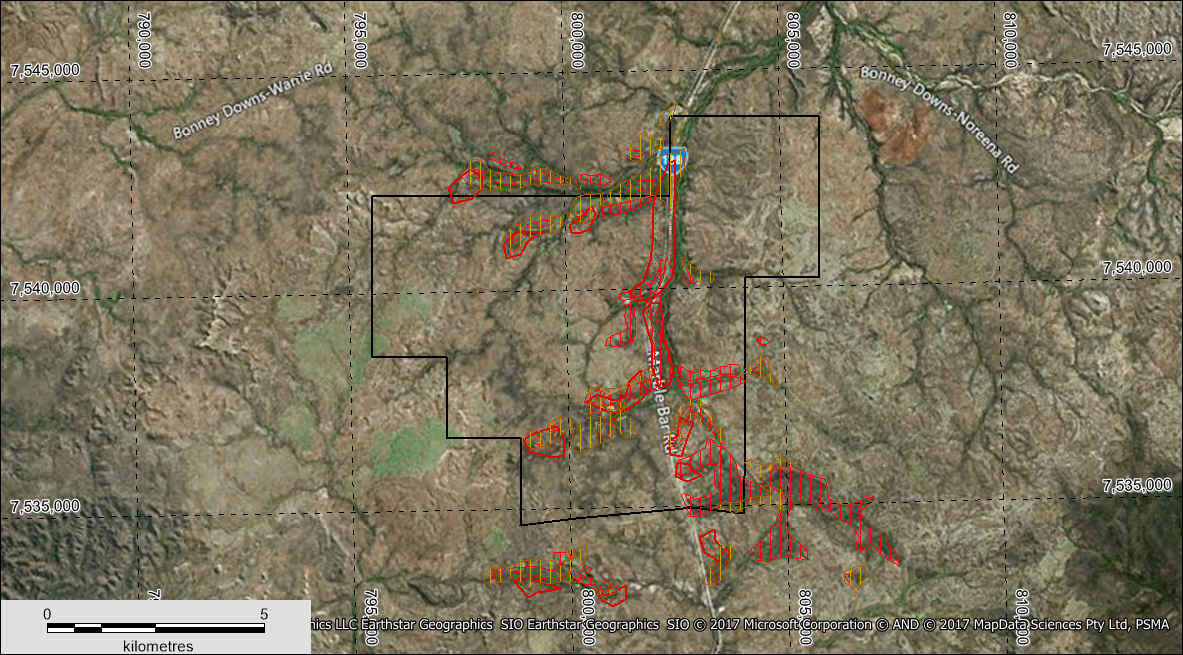Pilbara Iron Project
| Hamersley Iron Project Overview | |
| ELs | E08/277-I, E46/1084-I and E45/4619-I |
| Tenement Status | Granted |
| Project Craton | Pilbara |
| Project Area | 230.4 km2 |
| Target Commodity | Iron |
| Target Stratigraphy | Channel Iron Deposit (CID) |
| JORC Resources | None |
| Available Reports | Annual Technical Reports, Western Australian Department of Mines and Petroleum Reports, Internal Company Memos |
| Proximal Major Projects |
|
| Exploration Program | |
| EPCs E08/277-I, E46/1084-I and E45/4619-I | Compilation of historical exploration, aeromagnetic/radiometric survey at minimum line spacing of 100 m, geological/regolith mapping and targeted soil sampling. In selected RAB/Aircore drilling of high priority targets). |
| Land Owners | Yarraloola, Red Hill and Bonney Downs Pastoral Properties. All station owners have been contacted and are supportive of Kaili Irons exploration programs |
| Native Title Claims | Kuruma Marthudunera (Combined) WC1999/012, Kariyarra People WC1999/003, Palyku WC1999/016 and Nyiyaparli WC2005/006 Native Title Claims covering the 3 Kaili Iron Tenement Applications. Native Title agreements are currently being finalised. |
| Environmental Considerations | No areas of environmental significance |
The Pilbara Iron Project comprises three (3) granted tenements located approximately 400 km south east of Port Headland. The target mineralisation style if “Channel Iron Deposit” (CID) which are currently being mined at several locations within the Hamersley Basin and Pilbara Craton. The Pilbara region of WA is one of the premier iron regions of the world with several world class iron ore mining operations. Kaili Iron has targeted the CID (Channel Iron Deposit) style of iron mineralisation (FIGURE 1) which are found in ancient palaeochannels resulting in cemented masses of concretionary iron oxides of hematite to hematite-goethite composition. Major producing CIDs include Robe River (Rio Tinto) and Yandicoogina(BHP). Typical composition of ore from Yandicoogina is about 58% Fe, 0.05% P, 4.8% SiO2 and 1.4% Al2O3. In the vicinity of the Bustler Bore tenement BC Iron (FIGURE 2 have defined a resource of 106Mt @ 53%Fe with an ore reserve of 27Mt @ 57% Fe. The mining operation is currently on care and maintenance and being evaluated for a start of operations up by Fortescue Metals.

FIGURE 1 PILBARA IRON PROJECT – SATELLITE IMAGE SHOWING THE THREE (3) IRON PROJECTS, RAIL INFRASTRUCTURE AND OPERATING MINES (Fe)

FIGURE 2 BUSTLER BORE TENEMENT SHOWING ADJACENT MINING OPERATIONS
FIGURE 3 BUSTLER BORE TENEMENT SHOWING MAPPED CIDs IN BROWN AND AREAS OF ELEVATED IRON FROM PROCESSED ASTER SATELLITE DATA

FIGURE 4 BEA BEA CREEK TENEMENT SHOWING OUTLINE OF MAPPED CID AND ADJACENT RAIL INFRASRTUCTURE

FIGURE 5 BEA BEA CREEK TENEMENT SHOWING OUTLINE OF MAPPED CID OVER AN IMAGE OF THE POTASSIUM RADIOMETRICS, WITH THE CID BEING ASSOCIATED WITH A DISTINCTIVE POTASSIUM LOW RESPONSE
The Darnell Hill project is located to the south west the Rio Tinto CID mining operations near the town of Pannawonica. Australian Premium Iron is currently looking into the feasibility of mining Stage 1 of their CID iron ore resource of 1.2Bt @ 56.4% Fe.
FIGURE 6 DARNELL HILL TENEMENT SHOWING OUTLINE OF THE MAPPED CID IN RELATION TO CURRENT MINING OPERATIONS AND PROPOSED HEAVY HAULAGE RAIL LINE
Red Hill Iron are proposing a new heavy haulage railway to link their West Pilbara Project (0.79Bt Reserve within a larger 2.7Bt resource) located east of the Kailis Darnell Hill project to the Ankatell Point neat Karatha. Kaili have used processed ASTER imagery to highlight areas if outcropping iron accumulation (FIGURE 7). Initial exploration by Kaili will involve geochemical sampling traverses across the CIDs using the companies Delta hand held XRF instrument in conjunction with geological mapping.
FIGURE 7 DARNELL HILL TENEMENT SHOWING A PROCESSED ASTER IMAGE WITH AREAS OF ELEVATED IRON RESPONSE SHOWN IN YELLOW TO RED COLOURS

